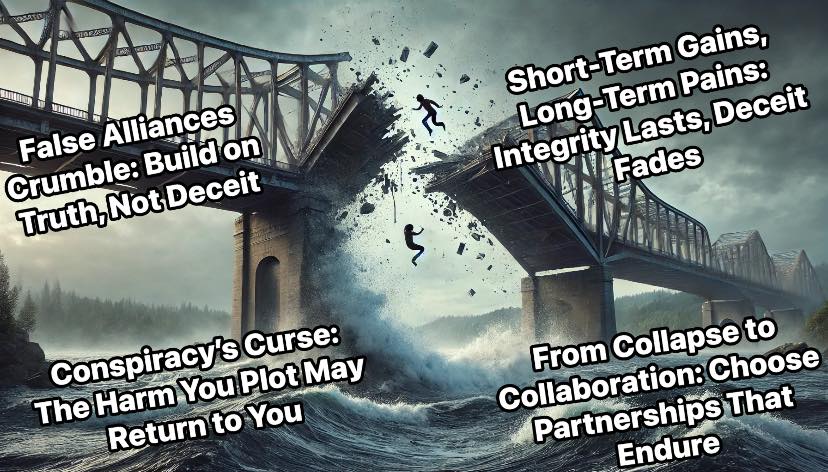
Kavi’s journey of uncovering patterns took a new turn when he observed a recurring dynamic in human interactions: the tendency for alliances built on falsehood and malice to eventually collapse. He noticed that when two individuals, groups, or nations conspired against another using deceit, their partnership often led to mutual distrust and conflict. Intrigued by this pattern, Kavi decided to explore its roots and implications.
The Pattern of Self-Destructive Conspiracy
Observation:
Kavi began by studying historical and contemporary examples of alliances formed to harm others. He saw that such partnerships were often rooted in short-term gains, fear, or envy. For instance:
Two coworkers might spread rumors about a third to undermine their reputation, only to later turn on each other when their own flaws were exposed.
Two nations might form a temporary alliance to weaken a common rival, only to end up in conflict over shared resources or conflicting interests.
Kavi noticed that these alliances were inherently unstable because they were built on a foundation of falsehood and mistrust. The very tools used to harm others—lies, manipulation, and deceit—eventually poisoned the relationship between the conspirators.
The Cycle of Self-Destruction:
Kavi identified a clear cycle in this pattern:
- Formation of the Alliance: Two parties come together with a shared goal of harming a third party. Their bond is based on mutual benefit, not trust or respect.
- Use of Falsehood: They employ lies, manipulation, or deceit to achieve their goal, often creating a web of deception.
- Erosion of Trust: Over time, the lack of honesty and integrity erodes the foundation of their partnership. Each party begins to doubt the other’s intentions.
- Internal Conflict: The conspirators turn on each other, either because their shared goal has been achieved and they no longer need each other, or because their deceitful tactics are used against one another.
- Collapse of the Alliance: The partnership falls apart, often leaving both parties worse off than before.
The Lesson:
Kavi saw this pattern as a cautionary tale about the dangers of building relationships on falsehood and malice. He realized that such alliances were not only harmful to the intended target but also self-destructive for the conspirators. The pattern highlighted the importance of integrity, honesty, and mutual respect in any partnership.
Kavi’s Solution: The Integrity Alliance Framework
To address this pattern, Kavi proposed the Integrity Alliance Framework, a set of principles for building healthy, sustainable partnerships:
- Foundation of Trust: Alliances should be built on honesty and transparency, not deceit or manipulation.
- Shared Values: Partnerships should be rooted in shared values and long-term goals, not short-term gains or malicious intent.
- Accountability: Each party should hold themselves and their partners accountable for their actions, ensuring that integrity is maintained.
- Conflict Resolution: Mechanisms for resolving conflicts should be established early on, preventing minor disagreements from escalating into major disputes.
- Focus on Growth: Alliances should aim for collective growth and mutual benefit, rather than the harm of others.
The Impact
Kavi shared his insights with his community, using real-life examples to illustrate the dangers of self-destructive conspiracies. He encouraged individuals, groups, and nations to adopt the Integrity Alliance Framework, emphasizing that true strength lay in building honest and respectful partnerships.
Over time, Kavi’s teachings transformed the way people approached alliances. They began to prioritize integrity over deceit, collaboration over manipulation, and long-term growth over short-term gains. The pattern of self-destructive conspiracies began to fade, replaced by a culture of trust and mutual respect.

